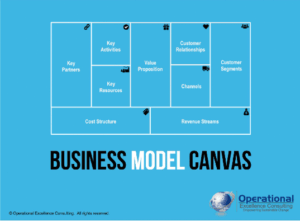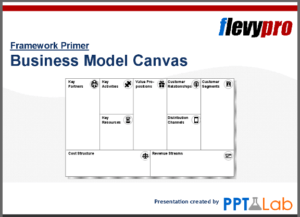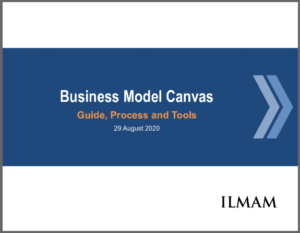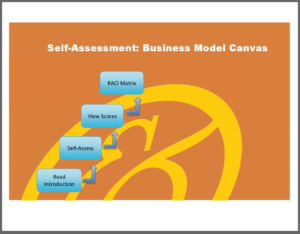A Business Model is an important input to organizational success. So how can you easily develop a good Business Model?
This post examines the Business Model Canvas, a simple tool that provides a template for building an effective Business Model.
What Is a Business Model Canvas?
 The Business Model Canvas encompasses the framework of what a Business Model is. It was originally proposed in 2005 by Alexander Osterwalder, who has earlier worked on an ontology for Business Models. To supercharge your understanding of business models, I recommend his book, “Business Model Generation: A Handbook for Visionaries, Game Changers, and Challengers”.
The Business Model Canvas encompasses the framework of what a Business Model is. It was originally proposed in 2005 by Alexander Osterwalder, who has earlier worked on an ontology for Business Models. To supercharge your understanding of business models, I recommend his book, “Business Model Generation: A Handbook for Visionaries, Game Changers, and Challengers”.
The canvas can provide a high level Business Model view of any organization. It requires thinking through nine key items – using the 80:20 rule – for the subject organization.
Note the dashed line through the center of the canvas, separating the items that are oriented to Value Creation, and those for Execution.
Rather than explaining the canvas, I will ‘take a wag’ at filling it – for the Project Management Institute (PMI) – noting that this is my perspective only for the example. Here goes:
- Customer Segment(s) – Project managers in any industry, any type of company, nonprofits, and government organizations; organizations who can gain value by better project management
- Value Proposition – Provide PM standards, certifications, and integrated community around them to enhance project performance and PM careers everywhere
- Channel(s) – Website; local chapters; network of training providers; testing channel; conferences
- Customer Relationships – Project Managers
- Revenue Stream(s) – Membership fees; books and related resources; training; conference fees
- Resources – The PM membership; staff; key organizations
- Activities – Conferences; publication; creating/vetting/updating standards; approving training; publishing
- Partners – Network of training providers; content creators and publishers
- Costs – Staff salaries; website(s); HQ facility; conferences
Note that having a big board and brainstorming in a group would be the best way to do this. The team could post sticky notes with these ideas right onto the canvas.
The Business Model Canvas is like using a template to construct a Business Model. It gets you into action on the basics of strategic business models. Getting good at Business Model generation can become a core organizational capability through the process of Business Model Innovation.
—————————————-
I recommend these strategy resources on FlevyPro (paid links):
| Business Model Canvas 140-slide PowerPoint deck and supporting PDF  |
| Business Model Canvas 22-slide PowerPoint deck  |
| Business Model Canvas: Guide, Process and Tools 43-slide PowerPoint deck  |
| Business Model Canvas – Implementation Toolkit Excel workbook and supporting ZIP  |
—————————————-
Now let’s go a bit deeper look with each of the items on the canvas.
1. Customer Segment(s)
 Initially the organization usually has a pretty good idea of who it wants to serve. However, this can change and evolve over time.
Initially the organization usually has a pretty good idea of who it wants to serve. However, this can change and evolve over time.
Here is how you might go about capturing the target customer segments:
- What is the customer avatar?
- How big a segment can the business handle?
- What are the demographics of the target customers?
- What are their geographic and social characteristics?
- Would it be better to scope the target customer population differently?
- Is there a priority or timing aspect?
Note that Customer Segment is listed first because it drives virtually all other considerations on the canvas.
2. Value Proposition
 A Value Proposition is all about solving a problem. Here are some approaches to think about:
A Value Proposition is all about solving a problem. Here are some approaches to think about:
- What is the customer’s job to be done?
- Is there a unique product or service for the customer?
- Is there a unique way of delivering the solution?
- Is there a need for a consistent solution, but perhaps with some degree of customization needed at some point?
- Are the drivers problems or needs?
The Value Proposition is at the core of the Business Model – hence its position prominently at the center of the Business Model Canvas. It is also evenly split between Value Creation and Execution.
3. Channels
 How does the organization deliver its products and services to customers?
How does the organization deliver its products and services to customers?
Here are some ideas to consider:
- Download, email, or app for digital products
- Storefront, either owned or through franchisee
- Retail sellers
- Distribution network, for both retail and business to business
- Network of partners who offer value-added services
Here are a few examples:
- Panera has a network of franchised restaurants.
- Starbucks has a network of company owned stores.
- UPS has a network of franchised storefronts, major distribution centers, online tracking, and doorstep delivery.
There are likely to be more than one of these choices, and often synergistically in alignment with each other – as with UPS. Channel consideration will be embedded in the value chain.
4. Customer Relationships
 Operationally, the organization must source, build, and renew relationships with customers.
Operationally, the organization must source, build, and renew relationships with customers.
Here are some questions to ask:
- How will we obtain new customers?
- How will we keep existing customers?
- How can we grow our base of customers?
You can only answer these questions by getting out and talking with customers and related stakeholders.
5. Revenue Stream(s)
 Core to the Business Model is how the organization will generate revenue.
Core to the Business Model is how the organization will generate revenue.
Here are some key considerations:
- How will we make money from each segment?
- What is the value we provide to the customer, and what can and should they pay for that value?
- What are some different techniques we can use generate revenue, such as product pricing, graduated levels, subscription, advertising, and membership?
- Do we need to provide some value for free, or at low price, as a loss leader?
There are many strategic considerations around the revenue question. Initially, just use some common sense and your experience to get started.
6. Resources
 On the operational side, you will need some core resources in order to execute. They include:
On the operational side, you will need some core resources in order to execute. They include:
- Financial assets
- Physical assets, such as facilities
- Intellectual property that provides and protects the foundation for products and services
- Customer lists
- Skilled people
You will need to determine the best combination of these resources that you need. You will need to determine which are most important and emphasize them accordingly.
7. Key Activities

Any organization has a set of key, or core, activities that it undertakes to add value.
Here are some common types of core activities:
- Production – How will we produce the products and services?
- Project management – Is this a project-centric business? Do we get paid for delivering projects?
- Supply chain management – Is the supply chain a key capability, and therefore a core activity?
- Problem solving – Do we solve unique problems that are posed, such as in a consulting setting?
Identifying the key activities is important in beginning to understand and shape the culture of the organization.
8. Partners and Suppliers
 Initially, a business will want to leverage established partners and suppliers as much as possible. This approach is likely to change significantly over time.
Initially, a business will want to leverage established partners and suppliers as much as possible. This approach is likely to change significantly over time.
Here are some questions to consider:
- Who is already serving our target segment(s)?
- What networks do we need to participate in?
- Should we build a network, or join an existing one?
- What strategic alliances, joint ventures, and related strategic relationships might help us to build a stronger position?
- What suppliers do we need in order to build and provide the products or services?
Answering these and related questions gets to the heart of the operation side of the venture. It forces digging into how the Five Forces exist in the industry.
9. Costs
 This is the final operational consideration.
This is the final operational consideration.
- What major costs/investments do we need in order to get started?
- What fixed costs will we have on an ongoing basis?
- What will be our variable costs?
- Are there potential economies of scale?
At the earlier stages, the focus is on developing a Business Model that is viable. Estimates may not be precise, but they need to capture the Rough Order of Magnitude (ROM) in order to be able to assess the viability of the Business Model.
The Business Model Canvas and Project Management
The Business Model Canvas is in essence a template – for building, understanding, and enhancing Business Models. It really works the same way as project management templates. It provides a proven framework, which enables you and your team to spend most of your time thinking.
—————————————-
I recommend these PM templates (paid link):
—————————————-
Here are six ways the Business Model Canvas can help you as a project manager:
- It helps you and the team to better understand the context for a project.
- It provides a proven framework to think through key aspects of Business Models that might be effected by a change being implemented by a project.
- It better enables and prepares you to speak the language of upper management.
- It can make you more valuable as a manager and contributor.
- It can help you to advance your career.

You can quickly and conveniently work through the components of the Business Model Canvas with the Lucidchart Business Model Canvas template (Try for free) – recommended!
Conclusion and Further Resources
How have you applied business models in your experience? Where can the Business Model Canvas help you?
Please share!
To supercharge your understanding of business models, I recommend “Business Model Generation: A Handbook for Visionaries, Game Changers, and Challengers” by Alexander Osterwalder.
I recommend this video for a short overview: The Business Model Canvas – 9 Steps to Creating a Successful Business Model”
For some direct learning from Alexander Osterwalder, who is credited with developing the Business Model Canvas, I recommend this video: “Tools for Business Model Generation”
—————————————-
I recommend these strategy resources on FlevyPro (paid links):
| Business Model Canvas 140-slide PowerPoint deck and supporting PDF $79 |
| Business Model Canvas 22-slide PowerPoint deck $25 |
| Business Model Canvas: Guide, Process and Tools 43-slide PowerPoint deck $59 |
| Business Model Canvas – Implementation Toolkit Excel workbook and supporting ZIP $149 |
—————————————-

